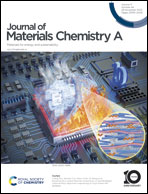A bio-inspired multifunctional interface layer for high performance zinc-ion batteries via novel in situ electropolymerization†
Abstract
Aqueous Zn-ion batteries (AZIBs) are promising candidates for next generation energy devices owing to their intrinsic safety. However, some irreversible issues, such as dendrite growth, hydrogen evolution and parasitic reactions, seriously limit their practical application. Functional interfacial layers, as a successful solution, can efficiently enhance the performance of AZIBs. Nevertheless, how to achieve accurate in situ construction and multifunctional design of the interface layer remains a great challenge. Herein, we propose a novel and universal in situ electropolymerization strategy that induces radical polymerization via electroreduction of initiators to construct an interfacial layer on the surface of Zn foil. The in situ electropolymerization strategy strengthens the binding force between the interfacial layer and Zn substrate, which leads to high rate cycle stability. Furthermore, a bio-inspired nacre like multifunctional interface layer was constructed via the in situ electropolymerization. Inspired by the brick–mortar structures of nacre, the inorganic conductive layered MXene and organic sodium polyacrylate (PAAS) are tactfully used as the hard and soft phases to assemble an organic–inorganic hybrid interface layer onto the Zn electrode (MX/PAAS@Zn). On one hand, due to the organic–inorganic hybrid structure, the MX/PAAS@Zn exhibits excellent mechanical properties, which effectively inhibit dendrites. On the other hand, the plentiful zincophilic carboxyl functional groups can effectively adsorb the Zn2+ and promote homogeneous deposition. The multifunctional modified Zn electrodes can effectively accelerate the Zn deposition kinetics and suppress dendrites, corrosion, and hydrogen evolution side reactions. As a result, the symmetric cell using MX/PAAS@Zn exhibits stable and reversible Zn stripping/plating, such as a high transference number (tZn2+) of 0.80 and an extremely low polarization voltage of ≈75 mV for 400 h at a terrifyingly high current density of 10 mA cm−2 and 10 mA h cm−2. The MX/PAAS@Zn//α-MnO2 batteries exhibit a negligible capacity decay rate of 0.023% for 1800 cycles at 1 A g−1, and maintain a capacity retention rate of 84% over approximately 600 cycles at 0.2 A g−1. The in situ electropolymerization of a biomimetic interfacial layer represents a promising strategy for promoting the practical application of high performance aqueous zinc-ion batteries.



 Please wait while we load your content...
Please wait while we load your content...